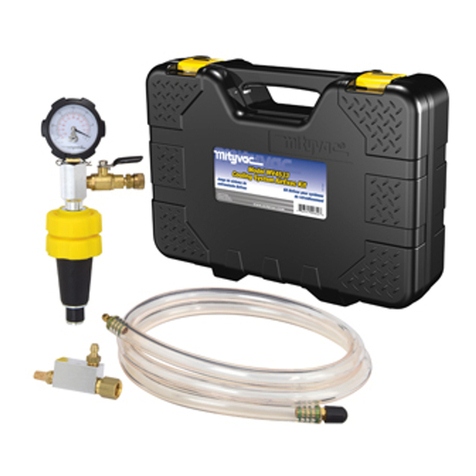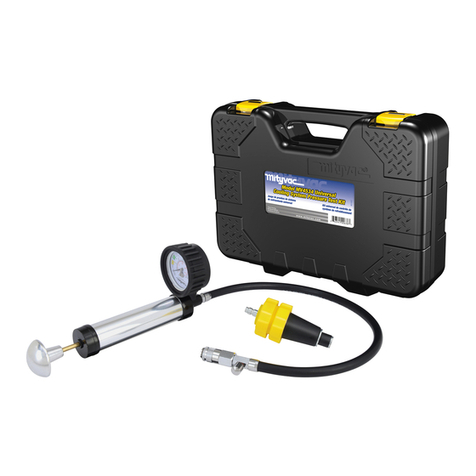Lincoln mityvac MV4529 User manual

AUG - 2007 Form 823094 Section - MV63-1
COOLING SYSTEM PRESSURE TESTER
MODEL MV4529
USER’S MANUAL
Have a technical question?
If you have questions, or require technical
service, please contact our trained service technicians
at:
1-314-679-4200 ext. 4782
Monday – Friday 7:30 am to 4:15 pm CST
Visit our website at www.mityvac.com for
new products, catalogs, and instructions
for product use.
Need service parts?
To order replacement or service parts, visit us online at
www.mityvacparts.com or call toll free 1-800-992-9898.

Page Number - 2 Form 823094
823037
823212
Table of Contents
Service Parts .............................................2
Schematics ...............................................3
Applications and Basics of Testing ............................4
Static Pressure Test (Engine Off) .............................5
Dynamic Pressure Test (Engine On) ..........................5
Cap Pressure Test .........................................6
Warranty .................................................6
French Version. ...........................................7
Spanish Version ..........................................15
Service Parts
Part Number Description
823037 Pressure Pump w/ Gauge
823212 Custom-Molded Case

Form 823094 Page Number - 3
Static Pressure Test (Engine Off) (See page 5)
and
Dynamic Pressure Test (Engine On)
(See page 5)
Cap Pressure Test (See page 6)
Pressure Pump with Gauge
Bayonet System Adapter
Radiator
Coolant Bottle
Threaded System Adapter*
Pressure Pump with Gauge
Bayonet Cap Adapter*
Bayonet Cap Threaded Cap
Threaded Cap Adapter*
* Not included, available for purchase seperately.

Applications & Basics of Testing
The MV4529 Cooling System Pressure Tester is designed to
diagnose and pinpoint the presence of leaks in an automotive
cooling system. It contains equipment to manually pressurize
and monitor a cooling system. Leaks are indicated by a drop
in pressure over a few seconds or minutes. The location of
external leak(s) is pinpointed by the visible seepage of fluid
resulting from the pressure. Internal leaks, which may not be
visible, typically indicate a blown head gasket or damaged
block or head, and can be diagnosed by monitoring the
pressure during a quick “engine on” test.
The MV4529 can also be used to test cooling system pressure
caps, which utilize a relief valve for protection against over-
pressurization. A malfunctioning cap can cause over- or under-
pressurization of the cooling system, leading to overheating and/
or severe engine damage. This test is performed using the pres-
sure pump included in this kit, however it also requires cap test
adapters that are not included with this kit, and must be
purchased separately. Refer to the Adapter Selection Guide
included in the kit for more information on cap adapters.
Precautions
This equipment is designed for servicing a variety of vehicles
in a safe, convenient manner. However, differences in cooling
systems may make it impossible to perform some of the tests
indicated in these instructions on every vehicle. The procedures
documented in this manual are to serve as guidelines for the use
of this equipment. In addition to these guidelines, always follow
the manufacturer’s recommended procedures when
servicing each unique vehicle. Do not attempt to force a test
on a cooling system for which this equipment is not designed
to perform.
Performing cooling system tests using the MV4529 is simple and
straightforward if you follow the instructions. However, always
keep in mind that you are working with a system that may be full
of cold or hot fluid that is under pressure and just waiting to be
expelled. If you are testing an engine that is hot and/or pressur-
ized, always stop to think before pressing the relief valve, remov-
ing a cap, or disconnecting a hose or other component.
Always read carefully and understand instructions prior to using
this equipment.
Always wear eye protection when removing radiator or coolant
bottle cap, or when performing any cooling system test.
Never remove the radiator or coolant bottle cap, or attempt to
pressurize the cooling system of a vehicle that is overheated.
Always allow system to cool prior to attempting to perform any
cooling system related test procedure.
Basics of Testing
When deciding where to connect to the cooling system,
first look for the radiator and determine if it has a fill neck
and pressure cap. This is common on about half of US
manufactured vehicles, and almost all Asian manufactured
vehicles, and would be the first choice for connecting. If the
radiator is closed and inaccessible, then the connection will
be made through a coolant bottle. Some automotive cooling sys-
tems utilize a coolant overflow bottle that is not part of the sealed
system. Attempting to test the cooling system through this bottle
will not connect you into the sealed system, and will simply vent
the test pressure to the atmosphere. This type of overflow bottle
is easily recognized because it typically utilizes
a snap-on style cap or a threaded cap that is open to atmo-
sphere. There are no adapters that are designed to fit this type
of coolant overflow bottle. A test connection should be made
through a radiator or coolant bottle with a bayonet or threaded
style of cap designed to maintain a specific pressure in the
cooling system.
Adapters
MV4529 includes one (1) bayonet style cooling system adapter
that fits most early and some late model US manufactures cars
and light trucks. This or an alternative adapter is required to
connect the test equipment to the cooling system of the specific
make and model being tested. Additional adapters are avail-
able separately for other US, Asian and European manufactured
vehicles. Refer to the Adapter Selection Guide included in this
kit for a list of applications for all system and cap adapters avail-
able from MityVac. Once the correct adapter is identified for the
vehicle being serviced, it can be used to perform all of the tests
outlined in this manual.
Page Number - 4 Form 823094

Static Pressure Test (Engine Off)
For diagnosing:
Cooling system leaks
Set-up & Procedure:
1. Ensure the cooling system is cool and not pressurized.
Carefully remove the radiator or coolant bottle pressure
cap.
2. Check to see that the radiator or coolant bottle is filled to
the proper level, and check hoses for visual damage or
leaks. Fill and repair as necessary prior to testing.
3. Select the correct Cooling System Adapter for the applica-
tion. Refer to the Adapter Selection Guide included in the
kit.
4. Apply water or coolant to the rubber gasket and/or o-ring
on the adapter, and install the adapter in place of the
pressure cap.
5. Install the Pressure Pump onto the System Adapter using
the quick-connect. Make sure the quick-connect sleeve
snaps forward to lock the connection.
6. Operate the Pressure Pump until the needle on the
pressure gauge moves to the end of the colored band
indicating the appropriate pressure range of the cap (see
Chart A).
7. Watch the gauge for a short period of time. If the pressure
reading drops, a leak is present.
8. With the system still pressurized, perform a visual inspec-
tion of the entire cooling system. Check hoses and connec-
tions for seepage, which would indicate a leak. Return to
the gauge and check the reading once more.
9. Most leaks are external, and visible seepage occurs.
However, a drop in pressure with no visible leakage can
indicate a blown head gasket or cracked block, where fluid
leaks into the combustion chamber. Visually inspect oil
and transmission fluid for signs of coolant. Proceed to the
Dynamic Pressure Test for better methods of diagnosing
internal leaks.
10. When testing is complete, release the pressure in the sys-
tem by pressing the Pressure Relief Valve located on the
pump hose near the quick-connect coupler (Fig. 5).
11. Repair leaks if necessary, and retest.
12. Disconnect components, clean and store them properly.
13. Refill the radiator or coolant bottle to the proper level, and
replace the cap.
Form 823094 Page Number - 5
Chart A: Cooling System Cap Pressure Test Ranges
Rated Pressure (PSI) Pressure Test Range (PSI)
4 3 - 5
7 6 - 8
10 9 - 11
13 or 14 12 - 16
15 or 16 14 - 18
18 16 - 20
20 18 - 22
30 28 - 30
Dynamic Pressure Test (Engine On)
For diagnosing:
Cooling system leaks Blown head gasket
Cylinder head damage Cracked block
Set-up & Procedure:
1. Ensure the cooling system is cool and not pressurized. Carefully
remove the radiator or coolant bottle pressure cap.
2. Check to see that the radiator or coolant bottle is filled to the
proper level, and check hoses for visual damage or leaks. Fill
and repair as necessary prior to testing.
3. Select the correct Cooling System Adapter for the application.
Refer to the Adapter Selection Guide included in the kit.
4. Apply water or coolant to the rubber gasket and/or o-ring on the
adapter, and install the adapter in place of the pressure cap.
5. Install the Pressure Pump onto the System Adapter using the
quick-connect. Make sure the quick-connect sleeve snaps
forward to lock the connection.
6. Start the vehicle engine and monitor the pressure gauge.
An immediate and rapid pressure buildup is an indication of
a breach between a cylinder and the cooling system, most likely
due to a blown head gasket. Immediately turn off the engine and
release the pressure in the system by pressing the Pressure
Relief Valve located on pump hose near the quick-connect cou-
pler. Disconnect the test equipment and replace the head gasket.
If no immediate or rapid pressure buildup is indicated, operate
the pressure pump to bring the system to normal operating pres-
sure. If the needle on the pressure gauge vibrates rapidly, this is
an indication of a smaller compression or combustion leak into
the cooling system possibly caused by a damaged block or head.
Turn off the engine, carefully release the pressure in the system
by pressing the Pressure Relief Valve located on pump hose near
the quick-connect coupler. Disconnect the test equipment and
make necessary repairs.
7. If no abnormal pressure buildup is indicated, carefully release
the pressure in the system by pressing the Pressure Relief Valve
located on the pump hose near the quick-connect coupler. Let
the engine run until it reaches normal operating pressure and
temperature. Turn off the engine and allow it to cool with pres-
sure still applied. Check for leaks as the engine cools. A leak
caused by a slightly loose hose clamp or a stuck hose clamp that
gives a false sense of tightness, may only be noticeable during
cool down.
Caution: This equipment is not designed to release pressure from
a hot engine. Do not press the pressure relief valve, or attempt
to disconnect the pump or adapter until the engine is completely
cool. Doing so will allow hot fluid to be released, possibly causing
severe personal injury.
8. When testing is complete and the engine is cool, release any
remaining pressure in the system by pressing the Pressure
Relief Valve located on pump hose near the quick-connect
coupler.
9. Repair leaks if necessary, and retest.
10. Disconnect components, clean and store them properly.
11. Refill the radiator or coolant bottle to the proper level, and
replace the cap.
Table of contents
Languages:
Other Lincoln Test Equipment manuals
Popular Test Equipment manuals by other brands

Redtech
Redtech TRAILERteck T05 user manual

Venmar
Venmar AVS Constructo 1.0 HRV user guide

Test Instrument Solutions
Test Instrument Solutions SafetyPAT operating manual

Hanna Instruments
Hanna Instruments HI 38078 instruction manual

Kistler
Kistler 5495C Series instruction manual

Waygate Technologies
Waygate Technologies DM5E Basic quick start guide

StoneL
StoneL DeviceNet CK464002A manual

Seica
Seica RAPID 220 Site preparation guide

Kingfisher
Kingfisher KI7400 Series Training manual

Kurth Electronic
Kurth Electronic CCTS-03 operating manual

SMART
SMART KANAAD SBT XTREME 3G Series user manual

Agilent Technologies
Agilent Technologies BERT Serial Getting started








